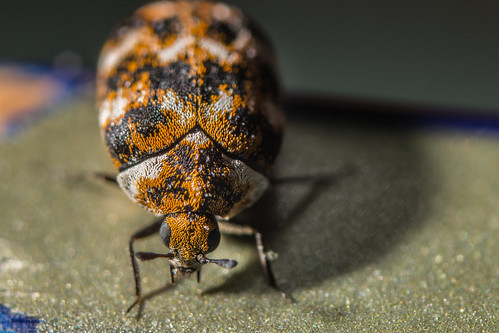Carpet beetles are a unique pest that feeds on various types of items that are animal-based; these include hair, silk, wool, leather, and fur.

What are Carpet Beetles?
Carpet beetles belong to the insect family known as “Dermestidae”. Considered to be a common beetle species, this is a type of pest that is known to invade residential homes, museums, and other structures where carpets, furniture, clothing, pillows, and other items that are made using animal substances are present.
These beetles are not known to invade areas where synthetically-created items are located; however, if those items are soiled by any type of food, oil, or bodily fluids, they may be attracted to them.
Once the carpet beetle invades an area, the infestation may spread quite rapidly.
The Carpet Beetle Bite and Potential Hazards
The carpet beetle is not known to bite; however, they possess hair fibers that may cause adverse reactions in humans and animals.
When the hair fibers come in contact with the skin of a person or animal, it can result in the development of a rash that is bumpy, red, and itches.
Many mistakenly believe that this rash is a result of bed bugs when, in fact, it stems from the carpet beetle.
In some instances, the fibers from the insect may become airborne.
When this happens, people or animals may experience irritation of the eyes and/or irritation of the respiratory tract. The insects are also known to invade areas where food sources are present.
How Do Carpet Beetles Get In?
Carpet beetles are known to live and to breed in the outdoor areas surrounding a structure. Their diet consists of nectar and of pollen.
They typically get inside of a structure by latching on to shoes and clothing.
They may also find their way indoors by being on plants or flowers that are moved inside.
Additionally, the carpet beetle has the ability to fly and are very small. This allows them to squeeze into a structure near doors, windows, and other cracks, such as near plumbing entrances, vents, chimneys, eaves, and conduits for electrical wiring.
Once indoors, the carpet beetle is attracted various items, such as animal hides, clothing, carpeting, and food items, such as noodles, flour, and pet food.
Carpet Beetles Vs. Bed Bugs
Throughout history, many people have mistaken the carpet beetle for the bed bug. This is due to the fact that they do resemble each other.

Common Bedbug
When looking down at the insect, it is flat and small, much like the bed bug. It is also oval-shaped.
The main difference is that the bed bug feeds on blood and the carpet beetle feeds on natural-based fibers in their larval stage.
Additionally, carpet beetles have the ability to damage those fibers – be it in a carpet or in clothing or another item that is composed of natural fibers or animal-based products. In adult form, carpet beetles do not look like bed bugs. Instead, they resemble fuzzy bugs that have hard spines on their body.
Identifying an Infestation
The adult carpet beetle is shaped like an oval. They are commonly black and white, but may have hints of yellow and/or orange on their body, too.
If you believe you have an infestation, you will need a professional pest control expert to confirm the infestation.
If you have beetle-like insects that move very slow or roll over if you make contact, you may have carpet beetles. These insects often hide in corners and places that are considered to be “hidden”.
Examples include underneath carpets, near windowsills, and underneath furniture. You may find feces pellets in areas where you believe the infestation is present.
Eliminating an Infestation
There are several steps that may be taken to reduce or eliminate an infestation of carpet beetles. The following outlines these:
- Vacuum all carpeting in the home.
- Wash all items that may be washed in hot water. These include curtains, bedding, winter clothes, and other types of clothing.
- Steam clean all flooring in the home.
- You may use extreme temperatures to eliminate carpet beetles. For example, if you find an infested blanket, you may freeze it for 48 hours to kill off the pests.
- Clean all surfaces with vinegar, as carpet beetles are deterred by this substance.
- Utilize boric acid throughout the home, but, be careful if you have pets.
- Use insecticides that target carpet beetles.
The safest and most productive method for eliminating carpet beetles is to have a professional pest control technician to treat the indoor and outdoor region of your home. To learn about this process, contact us today at: https://allpest-thoroughcheck.com/richmond-pest-control/

